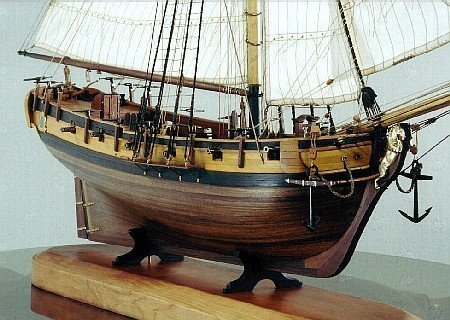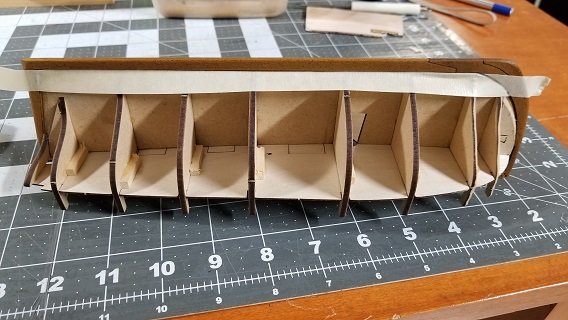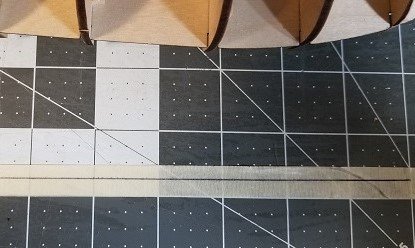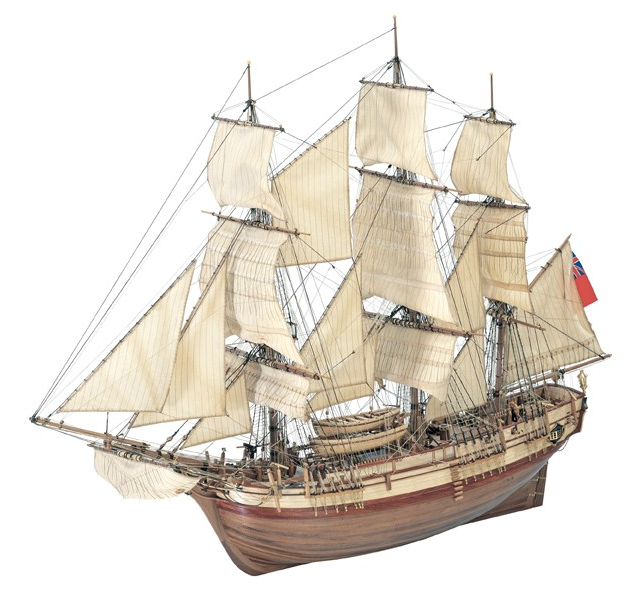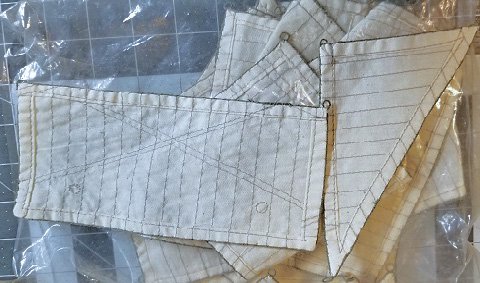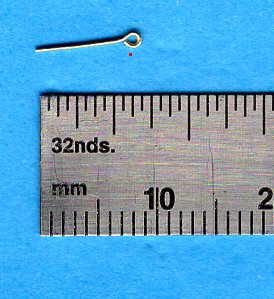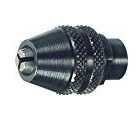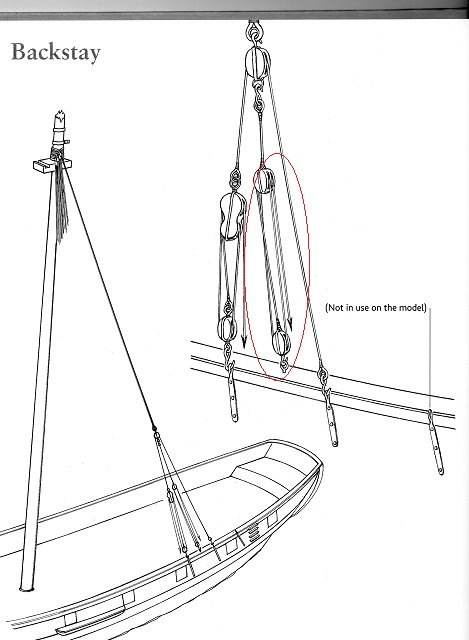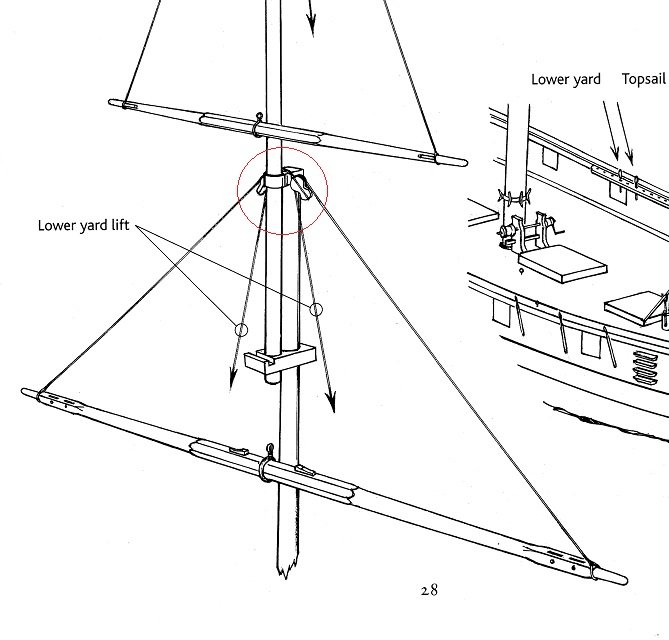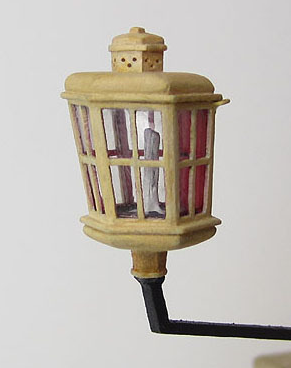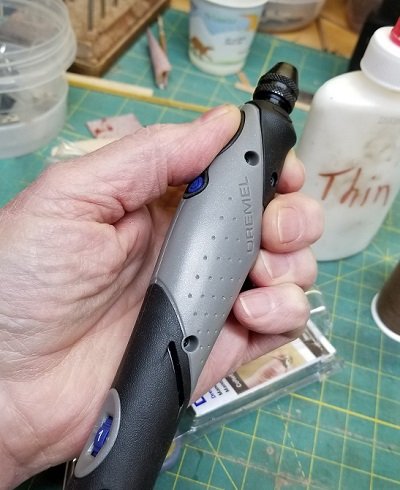-
Posts
3,152 -
Joined
-
Last visited
Content Type
Profiles
Forums
Gallery
Events
Everything posted by Gregory
-
I don't know if this will need further explanation, however when I lay out the garboard ( and other planks as well ) I place a piece of masking tape along the keel, from the stern to the bow. For most of the run, the edge will follow the keel. Where it meets the curve of the bow, I mark it with a pen, then use this as a guide for cutting the plank. Of course, the plank can be tapered and meet the keel further back,. The final shape is up to the builder and the desired result.
-
Going through may stash and uncovered a complete set of OEM sails for the Artesania Latina 1:48 Bounty. These are also for the " exposed " kits, and will possibly work for any 1:48 similarly rigged ship. I am willing to donate these to anyone who will pay postage and assure me they will be used on a model. I look forward to seeing them on a completed ship.. P.S. Trivia regarding the old MSW site: Does anyone remember the " Moldy " Bounties?
-
Make note! The spru has several sizes, and there are only ten of the smallest size...
- 714 replies
-
- lady nelson
- victory models
-
(and 1 more)
Tagged with:
-
This showed up in another discussion.. Eyebolt No Collar Might be what you need for making smaller hooks.
- 714 replies
-
- lady nelson
- victory models
-
(and 1 more)
Tagged with:
-
I just eyeball the opening and go from there. The drill bit idea sounds good for getting a little more precision. I burred up the edges of the chuck teeth a little bit with a cut off wheel. It doesn't take much to turn it into a rough cutting tool. I used to do this with various size colletts before I discovered the chuck.
-
Just curious.. Could you humor us with some context? In the image below, is the smallest eyebolt I have in my collection at about 1mm ID.. The red dot is about .25mm .. It is barely visible when printed and smaller than most of the thread I own. P.S. I certainly admire the effort that requires anything at this scale.. It is way off of my radar..
-
Thanks for sharing.. I was really impressed by by the precision of your parts, and was waiting for you to tell me you have a laser cutter.. Now I'm even more impressed! P.S. Regarding rounding off small square stock. You have made a very nice tool, however, I have found that a Dremel keyless chuck does a pretty good job, and gives you a fairly wide range on a small scale.. It's also good for further reducing round stock.
-
Hey Phil, Nice build you have going here. Just curious how you fabricate your wood parts, such as your gun carriages?
-
I've pointed out more than once that Petterson makes no claims about technical accuracy, and that he is documenting specific models. The objections here, come from discussions where someone asks for rigging references and Petterson gets thrown in with with Lees, and etc.. The distinction is important. I love Petterson's books. Particularly the first one. I go to them all the time. They are very good for showing how 99% of the lines run.. Particularly on the three mast ship..
-
I don't want to spend too much time bashing the book, but hope to address questions that have been asked.. Frankie may want to add more, but here is my $ .02 on the cutter. ( ...which is a favorite subject of mine for modeling, because of it's simplicity.) Being a relatively simple rig, it is hard to mess up, but one should be careful with kit plans, because they tend to oversimplify, which can be seen when you compare them to more detailed resources. Petersson apparently documented what he found on one model without comparing to other sources. Here are two items I question from the book, and maybe someone else can correct me if I am wrong. I don't understand the purpose of the tackle circled in red. It appears redundant if not totally unnecessary . It could conceivably be used to tension the back stay while setting up the other tackle that is seen, but I can't find this set-up anywhere else. It just jumped out at me when I was doing research for a couple of kits I am looking at. I don't see it in the contemporary model found here: There are several other cutter models in the Gallery, and I don't see that tackle on any of them. ....Or in the plans for Chuck's Cheerful, that can be found here: Chapter 14.. Chuck is not the final word, but I know he researched his Cheerful very thoroughly, and I would feel comfortable rigging any similar cutter with his plans. Here's No. 2: What's up with those fiddle blocks? There are not any lines going through the lower sheave. Regardless, I don't think you will find such blocks as part of a yard lift tackle on any ship. Some may say these are no big deal, but it certainly disqualifies this book as a go-to, much less a final source for accurate information on a similar boat. As I mentioned, these are two problems that jumped out at me as I compared it to other sources. I don't want to spend a lot of my time, analyzing this book for other errors, but I must assume they are there, and will double check anything I find myself looking at for future reference. Of course, someone more knowledgeable than me, might look at what I have posted and inform me about how wrong I am. I will certainly welcome any criticism. Gregory
-
Frankie might have more to say, but the problems arise from the subjects Petersn chose for his reference. He claims he studied contemporary models and draws them as he found them. Some of his details are just wrong regarding how a particular line leads from here to there, on a real ship. This may ( probably ) be because the model in question was /is in error. There is no reason to doubt that Petersn accurately documented what he observed. I was oblivious to this until Frankie pointed it out, but I would have to dig to find an example, which I might do later. Personally, I like both of his books, but now know not to accept them as being accurate without a lot of double checking.
-
Model Ship Building Stands And Vices
Gregory replied to LEGION 12's topic in Modeling tools and Workshop Equipment
I don't care too much about the stands, but I would like to hear more about the " vices ".. -
I really like the weathered look of your deck.. Regards, tapering. There are those who will decry the use of something like an Xacto blade or scalpel, because of a tendency for the blade to follow the grain, making precise cutting, where you want it, difficult. However I have found with patience and careful prep, it can be very effective, particularly for straight lines. Cutting curves become a whole new problem. In the short video below, I show how I marked a strip, and tapered it a few inches, from 10mm to about 8 with an Xacto. You have to make sure the straight edge and strip are held very firmly, and make the cut with several shallow cuts. Taper.mp4 Here is an excellent log of this ship, showing some planking technique. HMS Bounty by Steve
-
Laser cutting questions
Gregory replied to SardonicMeow's topic in Modeling tools and Workshop Equipment
I have used this 1/8 plywood from Amazon. 3 mm 1/8" x 8" x 8" Premium Baltic Birch Plywood P.S. You can shop around on Amazon for various dimensions.. This is more versatile at 12" x 24" .. 3 mm 1/8"x 12"x 24"Premium Baltic Birch Plywood -
Laser cutting questions
Gregory replied to SardonicMeow's topic in Modeling tools and Workshop Equipment
Don't shy away from good quality plywood for your frame parts. A good example is Chuck's Cheerful project. Click through the log to see the plywood framing.. Of course, you don't want plywood showing on the outside of your model, so the " finish " parts should be woods like boxwood, pear and the Alaskan yellow cedar that is showing up lately. There are many other choices, but those are a few. How precise your cutting is, will depend on the machine itself, and you will have to experiment. The best examples I know of is our own, Chuck Passaro's Syren Ship Model Company He turns out parts in boxwood that are 1/32" thick, and having dimensions in that range, if not smaller, also. Stern Lantern Kit For what it's worth, I have a low power laser engraver that needs several passes to cut through anything thicker than card stock. However, it is great for making precise patterns that I can then cut out with my jig saw, and follow up with detailed finishing. -
What first wooden ship kit should I buy.
Gregory replied to SHIPSCAT's topic in New member Introductions
Another good thing to keep in mind, If you happen to purchase a kit from ModelExpo ( which also has an eBay store ), they will replace lost or broken parts, no questions asked... -
Thanks for taking the time... With all the kits we have going here, and assuming the plans are fairly accurate, comparing the steeve angles might be an interesting exercise.
-
Perhaps you could share a brief synopsis of his conclusions before we all rush out and buy the book?
-
I came across this the other day while strolling through Walmart.. 2050-15 Stylo-Plus I'm posting the Amazon link due to extra pictures. I couldn't resist. It comes with the standard colette that fits most other Dremels. I added the Dremel keyless chuck. It is very light, and doesn't feel much bigger than a large pen when held. It doesn't seem as big as the illustrations at Amazon indicate. ( A model with small hands maybe? ) It has a small 18v power supply with a very lightweight cord.
About us
Modelshipworld - Advancing Ship Modeling through Research
SSL Secured
Your security is important for us so this Website is SSL-Secured
NRG Mailing Address
Nautical Research Guild
237 South Lincoln Street
Westmont IL, 60559-1917
Model Ship World ® and the MSW logo are Registered Trademarks, and belong to the Nautical Research Guild (United States Patent and Trademark Office: No. 6,929,264 & No. 6,929,274, registered Dec. 20, 2022)
Helpful Links
About the NRG
If you enjoy building ship models that are historically accurate as well as beautiful, then The Nautical Research Guild (NRG) is just right for you.
The Guild is a non-profit educational organization whose mission is to “Advance Ship Modeling Through Research”. We provide support to our members in their efforts to raise the quality of their model ships.
The Nautical Research Guild has published our world-renowned quarterly magazine, The Nautical Research Journal, since 1955. The pages of the Journal are full of articles by accomplished ship modelers who show you how they create those exquisite details on their models, and by maritime historians who show you the correct details to build. The Journal is available in both print and digital editions. Go to the NRG web site (www.thenrg.org) to download a complimentary digital copy of the Journal. The NRG also publishes plan sets, books and compilations of back issues of the Journal and the former Ships in Scale and Model Ship Builder magazines.

